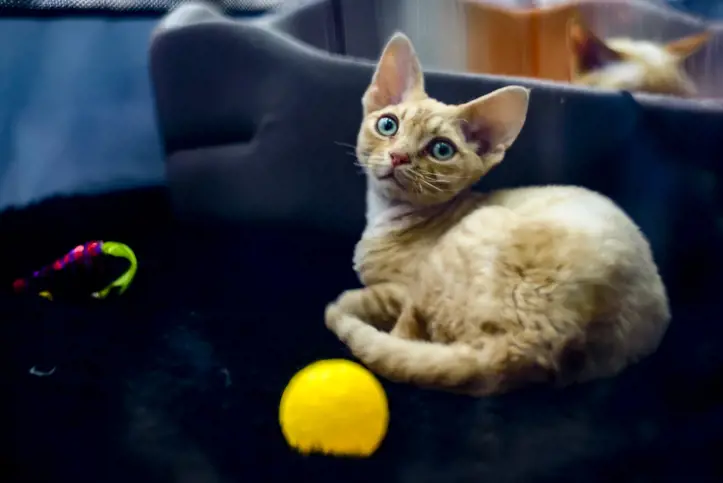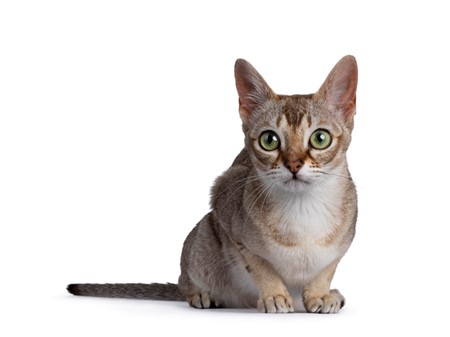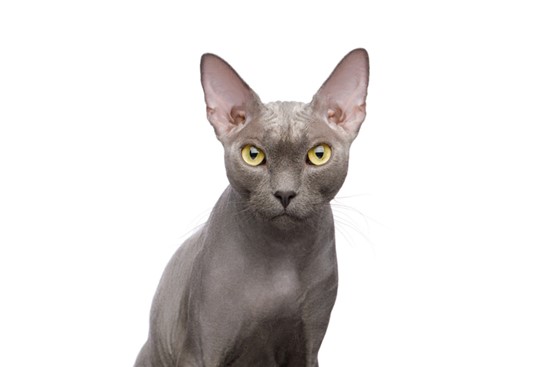Best small cat breeds that look like kittens forever
18th August, 2021

What’s better than a cat that’s super cute? Yes, you’re right, one that’s super cute AND super tiny! As if choosing the right cat for you and your family wasn’t hard enough, we’ve just made it so much harder.
Any one of these small cat breeds will look like kittens forever and bring a hefty dose of aww factor to your home! In this article we’ll learn more about the smallest cat breeds, their unique personalities and appearances and tips on how to care for these little cuties.
No matter how cute and cuddly they are, cat insurance helps you to give your tiny kitty the care it deserves throughout its life. And did you know our Gold products have been awarded a much-coveted 5* Defaqto rating for 2021? If you care about your cat then we can arrange a quick quote today and get them covered.
If you’re just about to welcome a new cat, check out our top tips for making them feel at home.
8 small cat breeds and their big personalities
Singapura
Regarded as the smallest cat breed available, the Singapura can often weigh in at a mere five pounds – that’s around half the size of an average house cat.
The Singapura, whose name is Malaysian for Singapore, comes from South East Asia where its distinctive striped tabby coat pattern and dark brown colour is a common local combination.

Singapuras don’t reach their full size until they’re two years old. A fully grown female will weigh between five and six pounds, while males will reach between six and eight pounds. This short-haired breed is also known for its adorably large ears and captivating eyes which can range in colour from celadon green through hazel or gold to copper.
Despite their small size, they’re curious and extroverted creatures regarded as excellent little helpers who are only too keen to get involved in any family activities. With a gentle voice they get on well with both children, cats and other pets. Tough, sturdy and energy-packed they also know how to chill-out and love cuddles.
Their short, dense and glossy fur doesn’t require a lot of grooming, and apart from lots of cuddles they’re pretty low maintenance. The average life expectancy of the breed is between nine and 15 years.
While they don’t have many specific health concerns, look out for progressive retinal atrophy (PRA) and pyruvate kinase (PK) deficiency.
Munchkin
One of the most famous breeds of small cats is the aptly-named Munchkin. Named after the small childlike creatures in L. Frank Baum’s book The Wonderful Wizard of Oz, Munchkin cats all possess a naturally occurring genetic mutation that results in shorter legs.
So, while their bodies are medium in size and they tend to weigh between six and nine pounds, it’s their short legs which get them into the small breed category.
With an adorable, smart personality they tend to play well with other cats and dogs, but also have a well-known tendency to be attracted to shiny objects and the game of hide and seek. A distinct drawback of their low-slung stature is they lack the jumping ability of most other breeds.
Owners need to be aware of potential joint injuries so cat insurance is a good idea. However, while similar to a dachshund or corgi shape, Munchkins don’t have the same spinal problems as their canine friends.
An interesting quirk of the breed is they will sit up on their hind legs like a rabbit to get a better view of something that catches their interest.
Cornish Rex
With an unusually curly coat, long legs and angular features the elegant Cornish Rex is smaller than it appears at first. Females usually weigh in at between five and eight pounds, while the males weigh between eight and 10 pounds.
Possessing only down hair they are super soft to the touch and usually regarded as hypoallergenic. With long agile toes another hallmark of the breed, they are known for getting up to mischief!
Highly intelligent, these gorgeous felines crave human interaction and love playing lively energetic games. Indeed, their behaviour is often described as dog-like in that they will often wait for their humans to return home and are even known to play an occasional game of fetch!
Despite their thin coat they are considered a hardy breed and relatively long lived at 16+ years. However, they can get cold quickly and shouldn’t be left out in the rain as they can soon become saturated.
Some cats, particularly those with pale coats, might require sun cream protection on their ears during the summer months. This breed is at risk from hypotrichosis – hair loss leading to baldness – as well as skin conditions like excessive yeast infections.
Devon Rex
Slightly smaller but with a very similar genetic heritage to their Cornish cousins, the Devon Rex generally weighs between five and seven pounds if female, and between seven and nine pounds if male.
To go with their large ears and Pixie-like appearance, Devon Rex are known for being intelligent, active cats with a mischievous temperament. Indeed, they can become destructive if they are left to get bored.
Their velvety soft, wavy coat doesn’t need much grooming but their social nature means they still crave a good stroking session! They love the warmth and as with the Cornish Rex they can be prone to yeast infections of the skin and baldness. The lifespan of a Devon Rex is typically between 12 and 16 years.
Scottish Fold
If you’re lucky enough to meet one, the first thing you will probably notice about a Scottish Fold cat are its distinctively small and tightly folded ears. Coupled with a solid, compact body, rounded head, short neck and somewhat short legs they have an adorably toy-like appearance.
They aren’t the smallest of ‘small’ cats, females can weigh between six and nine pounds while males reach between nine and 13 pounds. However, with a sweet melt-your-heart expression to match their affectionate and gentle nature you’ll certainly feel like you’re living with a chunky kitten!
Unfortunately, the genetic mutation that causes the ears to fold means some Scottish Fold cats suffer from painful degenerative joint disease. This disease causes the joints to stiffen, bones to fuse and movement to become more difficult and painful. Some cats progress from a slight lameness to an unwillingness to move.
Even if your cat doesn’t seem to have this condition, it’s still important to book in regular check-ups with your vet to keep an eye out just in case. Having cat insurance in place means you can get the best veterinary help, and fast.
Another issue to take into account are those cute little ears. While they look sweet, the Scottish Fold's ears are tricky for the cat to clean itself. So, you’ll need to regularly remove any build-up of wax or dirt to prevent an ear infection.
If you’re thinking of inviting one of these darling creatures into your family then read our guide to Scottish Fold cats to help you decide if this breed is right for you.
Balinese
If you think you recognise the fine-boned, slim Balinese breed, that’s because it’s closely related to those super-popular Siamese! However, there are a few key differences between the two breeds. First, they’re somewhat smaller than their Siamese cousins. Females weigh between five and seven pounds while males weigh between six and eight pounds. Second, they have much longer fur coats that are silky and soft – but surprisingly easy to groom.
In terms of similarities, they are extremely intelligent and loving creatures who enjoy playing games and being sociable with family and other pets. They’re quite chatty and are more than happy to let their views be known. Like the Siamese, they are quite long-lived with an average lifespan of between 18 and 22 years. PRA has been identified in the breed, so needs to be checked for.
Sphynx
The intriguing, hairless appearance of the Sphynx breed means they can seem much smaller than breeds with thicker or longer fur. With females weighing between six and eight pounds and males weighing between eight and 11 pounds they are still on the smaller end of the feline spectrum.
However, don’t let their unusual looks fool you. They are muscular cats who simply love to play and interact with other people and animals. Indeed, they tend to follow their owners around like a puppy and will love greeting you at the door when you come home! Due to their outgoing and child-like behaviour it’s best not keep them as the only cat in the house – indeed another Sphynx would be ideal!
In terms of care, because they lack a coat, body oils are not absorbed as easily so they can sometimes need bathing (which most seem to enjoy). Their ears and feet can get dirty so they might also require a bit of TLC. Because their bodies need to constantly work to keep warm, they might also need a diet that’s slightly higher in calories.
If you have cat insurance with Purely Pets it’s worth checking if a specialist diet is covered by your policy.

Hypertrophic Cardiomyopathy (HCM) has been reported to affect young to middle-aged Sphynx cats. A routine annual health check with the vet is a necessity.
Dwelf
If you like the sound of the Sphynx, then you might have heard of a new breed of small, hairless cat called the Dwelf!
It weighs in at a mere four to six pounds and only seven inches in height. A cross between a Munchkin, an American Curl, and a Sphynx it’s a very distinctive combination.
World’s smallest cats
Even if you don’t choose one of these breeds for your next feline friend you could still have a tiny kitty on your hands. Many breeds are capable of producing smaller versions depending on the litter.
For example, according to Guinness World Records the smallest domestic cat on record was a male blue point Himalayan-Persian, named Tinker Toy. He measured only 7cm tall and 19cm long when fully grown! The Catnip Times reports the current holder of the smallest living domestic cat title is Mr Peebles, a grey tabby cat weighing just over three pounds.
If you want to be assured of seeing the tiniest cats around then you’ll have to visit an animal sanctuary or park. The endangered Rusty-spotted wild cats are from Indian and Sri Lanka and measure between just 35cm and 48cm in length. At birth they are no bigger than mice!
There are believed to only be around 50 of the species in captivity in the world. So, if you want to catch a glimpse of these rare and elusive animals then visit the Porfell Wildlife Park and Sanctuary in Liskeard, Cornwall.
Get a cat insurance quote with Purely Pets
From the Balinese to the Singapura, all breeds of cat will provide you with wonderful friendship but also a range of challenges. We can also help in making your choice between female or male cats a little easier by reading about this on our blog.
Arranging the most appropriate insurance cover is the only sure way to secure them the very best care around. The caring team at Purely Pets work hard to secure cover to suit all budgets and the needs of both cats and their loyal owners.
Whatever your kitten emergency, if you’ve taken out a policy through Purely Pets, you’ll get cover for vet fees ranging from £1,000 to £15,000 per year. You can even choose an excess level starting from just £60.
With 15 levels of lifetime cover available, many policies can also give you added benefits such as cover for dentistry, loss of pet, third party liability and overseas travel. While our online policy management portal gives you the complete flexibility to manage your policy at a time to suit you.
Purely Pets can provide you with an online quote for your cat within minutes. Our specialist insurance team is only a phone call away and can provide you with a quote or discuss your options in more detail.
Get a quick quote for cat insurance today.
Policy benefits, features and discounts offered may very between insurance schemes or cover selected and are subject to underwriting criteria. Information contained within this article is accurate at the time of publishing but may be subject to change.
Helpful Pages
Recent Posts
Pet Insurance Quote
- 98% claims paid *
- Claims paid directly to vets
- 24/7 vet video consultations
- Interest free monthly payments




